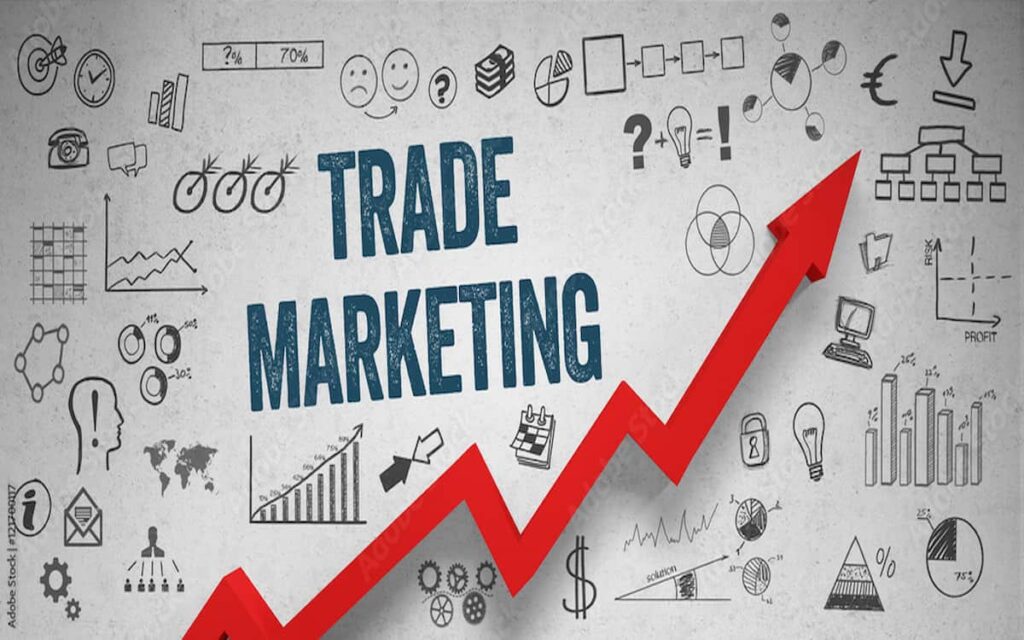Trade marketing might sound like a term reserved for corporate boardrooms, but its impact reaches far beyond big business. This article explores the ins and outs of trade marketing, its importance, and four potent strategies to elevate your business game. No complex jargon, just a straightforward guide to help you navigate the world of trade marketing.
What Is Trade Marketing?
Trade marketing is the unsung hero of B2B marketing, strategically weaving relationships in the supply chain. While shopper marketing dances with end consumers, trade marketing waltzes with businesses – retailers, distributors, and wholesalers. It’s the backstage pass to success, where the spotlight shines on seamless collaboration rather than individual transactions.
Why Is Trade Marketing Important?
In the intricate dance of distribution, retailers play the final act. They hold the market’s pulse, orchestrating in-store strategies that elevate business. Retailers play a pivotal role in sourcing products to various channels, including distributors, wholesalers, and manufacturers. Hence, the existence of a proficient trade marketing team becomes paramount.
Benefits of Trade Marketing
Scalability for All Sizes: Trade marketing strategies prove versatile, propelling sales for companies of all sizes. Small-scale enterprises can introduce enticing programs and rewards for channel partners keen on retailing their products to end consumers. Simultaneously, larger corporations can leverage these strategies by implementing incentive or reward programs to attract more channel partners.
Consistent Profitability: Think of trade marketing as a reliable friend; it ensures a steady stream of business from distributors and partners, consistently contributing to your company’s revenue and profit.
Competitive Edge: Trade marketing is a potent business tool to compete in product distribution. Effective strategies guarantee product visibility and accessibility in grocery stores, increasing the likelihood of purchases over rival products.
Wider Market Reach: Trade marketing proves invaluable for penetrating diverse markets, including grocery stores in smaller towns or districts. When executed effectively, these strategies offer a competitive advantage and foster mutually beneficial relationships with distributors and retailers.
How Does Trade Marketing Work?
Trade marketing, a symphony of strategy, relies on a dedicated team led by a trade marketing manager. This team crafts a plan and brand strategy tailored for businesses in the supply chain. The goal? To differentiate products and forge strong, mutually beneficial relationships.
4 Trade Marketing Strategies
In the silent battle for shelf space, trade marketers employ various tools to sway B2B partners. Let’s uncover the four strategies that ensure success in this intricate dance.
1. Digital Marketing
Digital marketing empowers companies to apply market research with precision. Social media platforms, email marketing, and digital advertisements synergize seamlessly with traditional personalized tools like phone calls and face-to-face meetings, creating a compelling outreach strategy.
2. Content Marketing
Establishing a recognizable brand is paramount in convincing wholesalers, distributors, or retailers to carry your product. Through paid ads, organic content, and social media engagement, companies can build brand awareness, connect with their target audience, and cultivate customer loyalty – a recipe for forging enduring relationships within the supply chain.
3. Trade Shows
Trade shows serve as industry congregations, bringing together companies across the supply chain and intriguing end-consumers. These events provide a unique platform to unveil demos, visuals, and product samples, spotlighting products’ unique selling proposition (USP). Real-time responses from potential business partners and customers enrich the experience, fueling future collaborations.
4. Special Offers
Trade marketers often dangle enticing promotions and incentives, such as discounts or bonuses, before supply chain partners. This strategic move motivates retailers, wholesalers, and distributors to actively showcase and promote the products, fostering a symbiotic relationship.
Conclusion
Trade marketing is the unseen force that propels businesses through the supply chain. In a world where relationships reign supreme, these strategies are the keys to unlocking success in B2B interactions.
FAQs
Q1: What sets trade marketing apart from shopper marketing?
Trade marketing focuses on B2B relationships with distributors and retailers, while shopper marketing targets end consumers.
Q2: How can small businesses benefit from trade marketing?
Small businesses can offer programs and rewards, enticing channel partners to sell their products.
Q3: Why are trade shows crucial for trade marketing?
Trade shows provide a platform to showcase products, present demos, and forge real-time relationships with potential partners.
Q4: How does digital marketing play a role in trade marketing?
Digital marketing, through channels like social media and email, allows targeted outreach to B2B partners.
Q5: Why are special offers important in trade marketing?
Special offers, like discounts and bonuses, motivate supply chain partners to carry and promote products.
